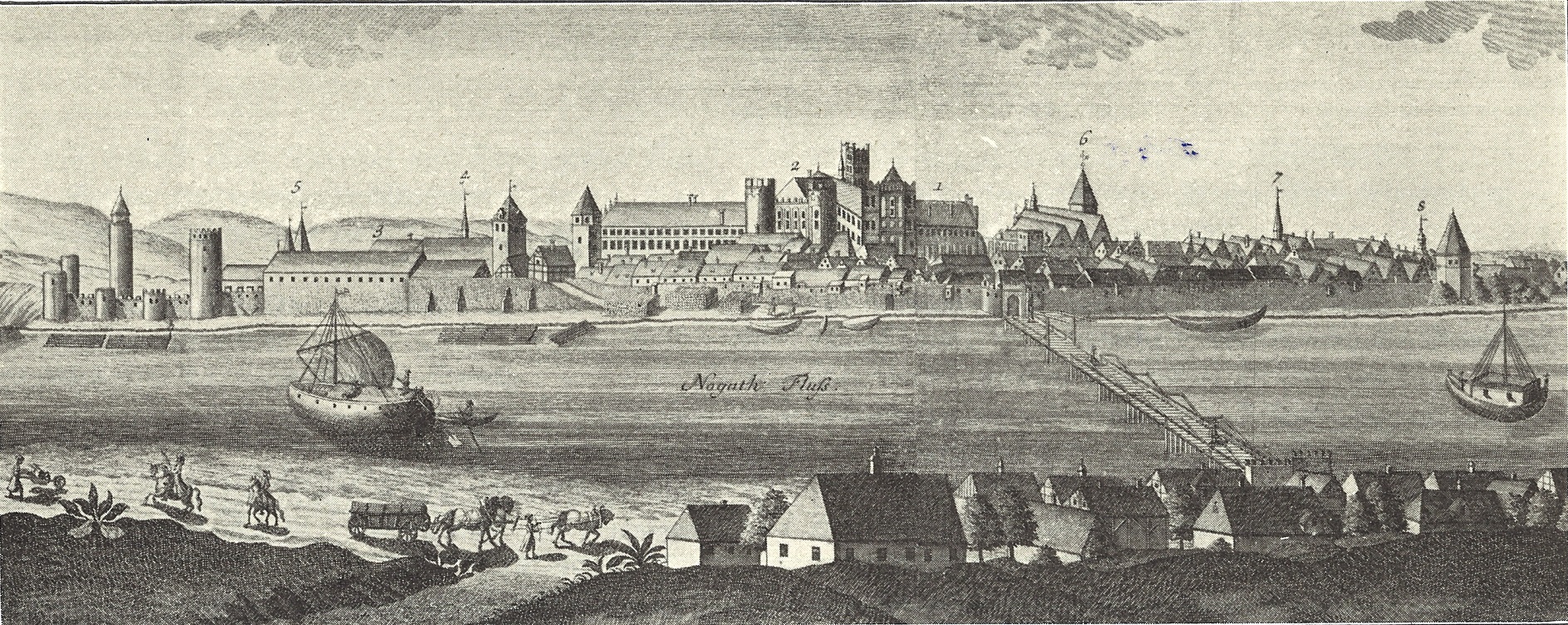Fig. Friedrich Bernhard Werner (1690–1776), after 1727 (?), Ed. Jeremias Wolffs Erben (heirs of Jeremias Wolff: Johann Balthasar Probst, Johann Friedrich Probst, Georg Balthasar Probst), Augsburg between 1727-1754
In the composition frame, in the middle of the river: Nogath Fluss
Paper, copperplate
Acquired by the Society for the Reconstruction and Beautification of the Malbork Castle in the period 1905–1908; stored in the Outskirts of the Castle in the former Heimatmuseum
In the horizontal frame of the drawing, the view of the castle and the city taken from behind the Nogat, against the background of the surrounding Żuławy landscape, turning into numerous hills in the depths of the composition. In the foreground a riverside track animated with a figural staffage; on the right, low buildings on the Kałdowa quay, separated by trees with leafy crowns. Boats and rafts on the river, in the center a wooden bridge leading to the Bridge Bastions. Behind the Nogat, a wide panorama of the castle and the city; the castle complex is shown schematically, in a simplified way, with defensive walls and towers from the river side. The body of the High Castle accentuated by the main tower topped with battlement; Palace of the Grand Masters and the West Wing of the Middle Castle shown in general outline; in Podzamcze there are modern craftsmanship buildings, from the north there is an extensive outer bailey with farm buildings. Within the Old Town (on the right), surrounded by a defensive wall, legible solids of the parish church of St. John and the town hall; in the suburbs the silhouette of the church of St. George.
The author of the prototype of the copperplate drawing is the Silesian artist, engineer, surveyor and traveler Friedrich Bernhard Werner, who undertook to make drawings for a series of large-scale engravings depicting views of famous European cities, on the basis of an agreement concluded around 1727 with the Augsburg publisher, Johann Balthasar Probst. He made a study trip to Poland and Prussia (mentioned in the autobiography), rich in various adventures, in the same year. He then visited, among others Gdańsk, Malbork, Elbląg and Królewiec.
The reproduction of Werner’s engraving, included in the 1908 Report on the Society’s Activities, does not show it in its entirety. The perspective of the view here is limited to the Teutonic Knights stronghold and the adjacent town. On other prints preserved in Polish museum collections there is an extensive legend along with publishing data. On the ribbon, in the center of the engraving, the title inscription: Marienburg; on the river twice: Nogath Fluss. At the bottom, evenly, in five rows: 1. Das alte Schloss .. 2. Das neue Schloss / 3. Das äussere Schloss. 4. S. Laurentz Kirchl. / 5. Das Sand Thor. 6. Die Pfarr. Kirch / 7. Das Rath Haus. 8. Das Marien Thor. / last single: 9. Lutherische Kirch in der Vorstadt. Below left: F.B. Werner del .; center: Cum Privil. Sac. Caes. May.; right: Heared. Ierem. Wolffy excud. Aug. Vind.
(by Justyna Lijka)

